Previous Blog – Part 1 – May 11, 2012
Let’s update the Cloud Battle story and discuss events since my last post on the subject
Square, Visa, Google, PayPal, Apple, Banks, … have recognized the absurdity of storing your payment instruments in multiple locations. All of us understand the online implications, Amazon’s One Click makes everything so easy for us when you don’t have to enter your payment and ship to information. (V.me is centered around this online experience). Paypal does the same thing on eBay, Apple on iTunes, Rakutan , …etc. But what few understand is the implication for the physical payment world. This is what I was attempting to highlight with PayPal’s new plastic rolled out last week (see PayPal blog, and Target RedCard). If all of your payment information is stored in the cloud, then all that is needed at the POS is authentication of identity (see blog).
The implications for cloud based payment at the POS are significant because the entity which leads THE DIRECTORY will have a significant consumer advantage, and will therefore also lead the breakdown of existing networks and subsequent growth of new “specialized” entities. For example, I firmly believe new entities will develop that shift “payment” revenue from merchant borne interchange to incentives
Since May, the following “significant” events “in the battle” have occurred:
- Retailers have launched MCX with Wal-Mart’s Mike Cook as the lead. I want to emphasize, this is not “mobile payments” but rather a low cost payment network (Cook talks about $0.05/payment). Some retailers will seek to integrate their loyalty card, others will create plastic (see Target RedCard), others will certainly couple with mobile. WMT will likely integrate with a virtual wallet that manages digital coupons (Coupons.com likely leading)
- Apple has rolled out Passbook in June.. See my Blog, and hardware analysis from Anandtech of why there is no NFC.
- PayPal had a marketing announcement with Discover. Why would you announce something like this with no customers? Paypal is expanding its network… but merchants are just laughing.. MCX wants a $0.05 payment, Durbin gave them a $0.21 payment and Paypal wants to get 180-250bps. As you can tell, I don’t think much of this, as the Merchants are still in control of their payment terminal. This is also not an exclusive deal with Discover. I expect 2 other major players to partner with Discover in next few months. Paypal just wanted to run with this announcement before the other products come out. I also want to emphasize that DFS is a BUY. They will be a partner of choice as they run a subscale 3 party network that can adapt much more quickly than V/MA. As a side note, Paypal will likely expand distribution of their own plastic. See related blog.
- Google rolled out Wallet 1.5 on August 1 (see blog). This is one of the biggest moves in payments and provides an enormous retailer value proposition (aligned to MCX). Google didn’t follow PayPal, Passbook, or Microsoft.. they rolled out product that was 1.5 yrs in progress. Google’s new cloud wallet allows the consumer to select any payment method, and provides the merchant with a debit rate (Bancorp non-Durbin 1.05% + $0.15 (note Google/Issuer can lower this for merchants, as any issuer could, this is a MAX rate). Google is CURRENTLY loosing money on the payment side of the business in hopes of making it up on the advertising side. This is no marketing announcement like Apple, Microsoft and Paypal.. this is a product announcement.. it is working today in my new Galaxy phone. This is also the first PRODUCTION cloud wallet for the POS. Apple, Amazon and Paypal dominate cloud wallets in eCommmerce and mCommerce. Google and Amex’s Revolution money are the only one’s doing it at the POS.
- Square acquired all 30M Starbucks mobile payment customers (see Blog). Square has done a great job acquiring merchants.. but was hurting on the consumer side. Square wants to build network and needed a pop on the consumer side. Square’s business is pivoting toward marketing and consumer experience. Within the next year, the little Square doggle will be a thing of the past. Starbucks is committing to the Square register experience, and Square is relabeling “card case” to “Pay with Square”.
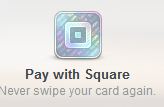
- LevelUp is making payments “free” for merchants as part of a loyalty value proposition. This is an example deal.. expect more to follow. Issue is that different merchants have different priorities. LevelUp is focused in QSR/Casual Dining and is operating as part of a loyalty play. I’ve outline their revenue in this blog, don’t think it is sustainable unless they can move into acquisition.
- ISIS has lost key executives in its product area, AT&T is rumored to have a NFC/Wallet RFP of its own out and even Verizon is planning to let Google go ahead and put its wallet on the Samsung Galaxy III phones.. after all what choice does it have?
- Card linked offers and incentives in the cloud. No one is making money in this space, large retailers are not participating, hyper local merchants (who are interested) are very hard to sell to, and consumers don’t see relevant content (thus redemption rates under 2%).
Where are the cloud battle lines? Well most significantly the battle lines are forming away from NFC (as I stated in January). Even my old friends at Gartner have caught up and placed NFC in the trough of disillusionment. To restate, NFC is not bad technology.. but it delivers no “value” in itself beyond control. Mobile operators have consistently failed to build a business around a “control” strategy (see my Walled Garden Blog). In the ISIS example they mandated use of credit cards only, as this higher credit interchange was the only way to make revenue. Well guess who pays the freight here? Yep the merchants… Wal-Mart and its peers were not thrilled at giving issuers and MNOs 3.5% of sales for the privilege of accepting a mobile payment.
The Cloud battle is complex, as the strategies are about MUCH MORE THAN PAYMENT. Payment is the ubiquitous service that is the last phase of a successful marketing, engagement, shopping, selection, deliver, retention, loyalty process. Leaders from my vantage point:
Payment Networks:
- Mastercard focused on acting in supporting role globally.
- Discover similar to MA, but with much greater flexibility as it operates in a 3 party network and is both issuer and acquirer.
- MCX – Not a leader yet, but has CEO mindshare of every top US retailer. They seem overly focused on the cost side. There is a very big whole in their customer acquisition strategy. MCX is bidding out its infrastructure now, my guess is that Discover or Target will win it.. and the the RFPs are just a way of keeping Banks “in the tent” to keep them from changing ACH rules to kill it like they did to Scott Grimes at Cap One (decoupled Debit).
- Google – has more consumer “accounts” than any company on the planet. Can it convert them to accounts with a linked payment instrument? Google also “touches” more customers, more times per day than any other company, its heavy influence in the shopping process positions it well with retailers. Also has the best retailer sales force of anyone on this list, as they bring in customers to retailers every day. Android/Google Wallet….
- Square – Best customer experience hands down (register). It also has the most traction among small retailers
eCommerce/mCommerce:
- Apple – expect Passbook to dominate mCommerce. It will be the killer app.
- PayPal – Challenged in market adoption beyond eBay/GSI customer base. Top ecommerce sites like Amazon and Rakuten have their own integrated payment, also 50% of eCommerce/mCommerce goes through Cybersource which Visa acquired. Paypal’s future growth driven by international
- Amazon – leading eCommerce/mCommerce player. When will it take one-click beyond Amazon? Amazon’s experience is best from end-end…. PayPal/Apple will operate around the periphery of non-Amazon purchases.
- Rakuten – “Amazon of Japan” who now also owns buy.com. Fantastic experience and leading eCommerce loyalty program.
How many places do you want to store your payment credentials? Who do you trust to keep them? What data do you want providers to know about you?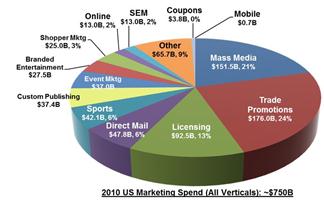
From a macro economic perspective, total payment revenue for all major participants is just under $200B in the US. Total marketing spend in the US is over $750B. Total retail sales in the US is $2.37T (not including oil/gas, Fin services, T&E). Marketing is fundamentally broken… payments is not. Retail sales gross margin has been compressed from 4.2% in 2006 to 2.4% in 2010. Who is best able to execute on the combined retail and marketing pain points? Who can be retailer friendly? Consumer friendly? Marketing friendly?
I start my analysis with #1 the consumer value proposition, and #2 the merchant value proposition. Entities like Google, Paypal, Apple already have tremendous consumer relationships and traction. They thus have very few “acquisition” costs. However, these entities do bear the costs of changing customer behavior. There are many approaches for changing customer behavior:
- Incent behavior – direct/indirect/merchant
- Customer Experience (ex Square)
- Service integration (reduce effort or # of parties)
- Reduce risk – financial (security/anonymity…)
- Reduce risk – purchasing (social, community reviews, …)
- Value proposition in commerce process (indirect incentives)
- Marketing
- ..etc
Other groups like MCX and ISIS bear the cost of both customer “acquisition” AND behavior change for: Consumer, Merchant or Both. As I state previously. one of my favorite arcane books I’ve ever read was “Weak Links” I’m almost reluctant to recommend it because it is so good you may jump ahead of me on some of my investment hypothesis. One my favorite quotes from the book
Scale-free distribution (completely open networks) is not always the optimal solution to the requirement of cost efficiency. .. in small world networks, building and maintaining links between network elements requires energy…. [in a world with limited resources] a transition will occur toward a star network [pg 75] where one of a very few mega hubs will dominate the whole system. The star network resembles dictatorships in social networks.
Networks like V, MA, PayPal, Amex and DFS are working to participate in this new Macro economic opportunity. But established networks are hard to change
“The network forms around a function and other entities are attracted to this network (affinity) because of the function of both the central orchestrator and the other participants. Of course we all know this as the definition of Network Effects. Obviously every network must deliver value to at least 2 participants. Networks resist change because of this value exchange within the current network structure, in proportion to their size and activity.”
The implications for cloud based payment at the POS are significant because the entity which leads THE DIRECTORY will have a significant consumer advantage, and will therefore also lead the breakdown of existing networks and subsequent growth of new “specialized” entities. For example, I firmly believe new entities will develop that shift “payment” revenue from merchant borne interchange to incentives (new digital coupons).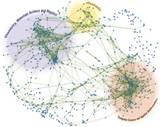
The current chaos will abate when an entity delivers a substantial value proposition that attracts a critical mass of participants. Today most mobile solutions are just replacing a card form factor… this is NOT VALUE. I am currently placing my bets on solutions that merchants support (Square, Google, MCX, LevelUp, …) as this is a key “fault” of almost every other initiative.
Comments Appreciated (as always sorry for the typos…)

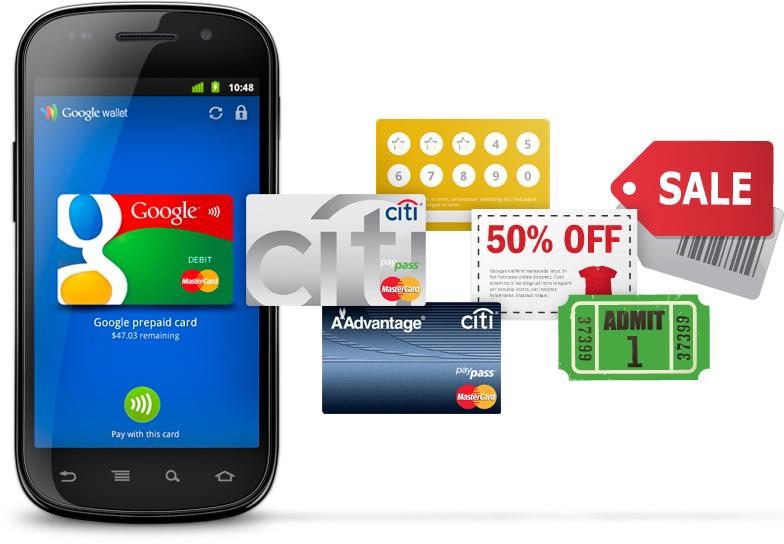
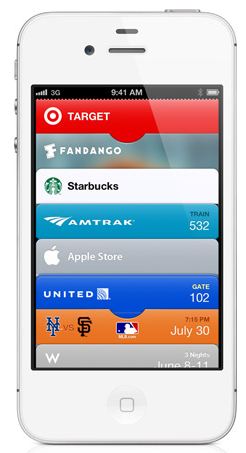
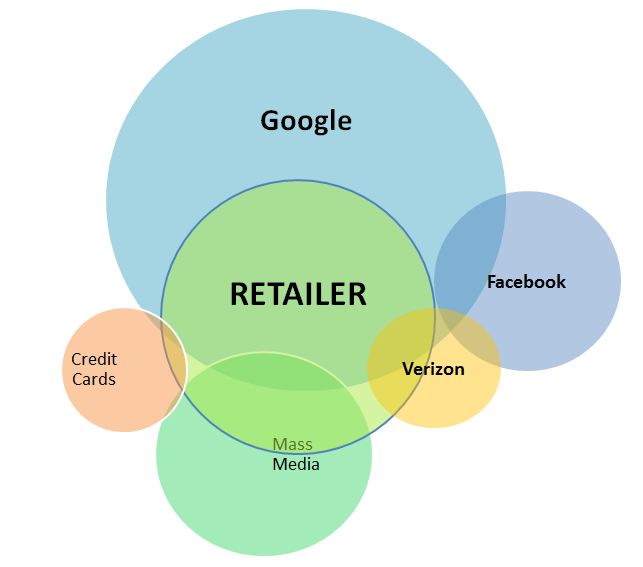
Excellent rundown of the (mobile) payments war, Tom. Thoroughly enjoyable!
I have a few comments. GW (Bancorp) are exempt from the Durbin’s interchange fee cap, hence GW costs retailers as much as most prepaid cards (which GW effectively is).
As to Square: if they drop the dongle, how will all those mobile/micro merchants interact with NEW customers?.. Most of such merchants do not have a barcode scanner (yes, you can emulate one via something like RedLaser app, but that would mess up UX).
Why are ATMs never mentioned when it comes to mobile payments. If the (mechanical) objective it so replace a physical wallet with a mobile phone, how does one withdraw cash? If I need to carry an ATM card with me, I might as well as carry the wallet too. What are your thoughts on that?
As we discussed in comments within http://tomnoyes.wordpress.com/2012/08/01/google-wallet-2-0-the-winners/
Bancorp is the bank behind the card. With assets of $3.011B their debit is not regulated. Hence my best guess at interchange is 1.05% plus a $0.15
I can’t agree on “most pre-paid cards” as it is a very complex matrix. GPR cards, pre-paid non-reloadable, gift, … 1% is a very low rate… but an even more important point.. GOOGLE IS IN CHARGE OF THIS RATE. They are the sponsoring entity and have control through the issuing bank. Google can make this rate 0 if they wanted to. This point is consistently missed in the press. Google can also set this rate (as any issuer could) differently for different merchants. 1.05% is the MAXIMUM..
Square.. look at my blog on square register.. think of enabling all starbucks customer to also pay with voice. Pay with Square AND Starbucks payment will be enabled for both customer sets.
How do you get cash out of Google wallet? you don’t. You get Cash out of your bank where your cash sits in the deposit account. Why do mobile payments have to address cash out? Mobile payments will integrate with whatever else you have in your wallet. Don’t put cash in a mobile wallet. In this world the only place to take money out is where it is stored (your bank)..
The only exception is developing countries where consumers don’t have a deposit account and all services are pre-paid.
Paymentsnews initially reported First Data involvement in MCX, but your post seems to indicate that Discover or Target will also play some role in the processing infrastructure. Is First Data in fact involved? If so, what role do you anticipate them playing vis-a-vis the other potential partners? Will Target National Bank provide credit to MCX merchant customers? Also, will MCX merchant issue both debit and credit products?
Don’t think of MCX as a well organized and well defined entity. All full time employees are “on loan” from other organizations (to my knowledge). Everyone in payments says they will be “involved” in MCX, but given that the processing RFP is still out (not awarded) who runs the infrastructure is not yet defined. Also note that Target already has a product in the market (RedCard) that is closest to what many MCX members want. Not all MCX members want the same thing, for example CVS will never abandon its loyalty program and wants to integrate payment here (similar to Target but differently), WMT has ELP, .. I could go on. Point here is that the only common services everyone agrees on is payment clearing for $0.05/transaction… retailers are competitors after all…
My belief is that DFS and Target are best positioned to execute in short term. Target has the product, and has solved the customer acquisition problem. DFS has the network (3 party) that can adapt to support this.
To your question on First Data, I’m sure my friends there would like to participate and are competing for the business. There is both an issuing and acquiring problem to be solved. A NEW 3 party network must be formed OR an existing one must be created. Target solved this problem because the Redcard only works in their own stores.
To create a new 3 party network, FD would need a bank partner like Citi (Chase would need Chase Paymenttech…) Discover needs no one and already has a solid base to start from. The base is not just consumers and merchants, but network agreements and rules on things like returns, refunds, … MCX has the best chance to succeed with DFS, I don’t see how they can achieve the interoperability unless they take this approach. However MCX is listening to new ideas as the RFP responses come in. I do believe that they are considering a form of check electronification, which is very similar to what Target has done. Does MCX provide common facilities to support many merchants rolling out similar products? or does it create a new standard merchant led Visa?
With DFS’ market cap of $19B, I believe they are in play.
Total retail sales – $2.3T (excluding financial services), total payments revenue (related to those sales, I guess) – $200B or… 10% of sales. Is that right?
I would not calculate as percent of retail sales. Banks pay substantial sums to support ATM systems, check processing, commercial payment, network fees….. Payments are a key function of financial services of which retail payments are less than half
Pingback: Don’t Wrap Me « FinVentures
Pingback: 2013: Payment Predictions – Updated « FinVentures
Pingback: Controlling Wallets – Battle of the Cloud Part 3 | FinVentures
Pingback: Payments Part of OS: What does that mean? | FinVentures
Pingback: Wells gets and A+: New Amex Partnership | FinVentures